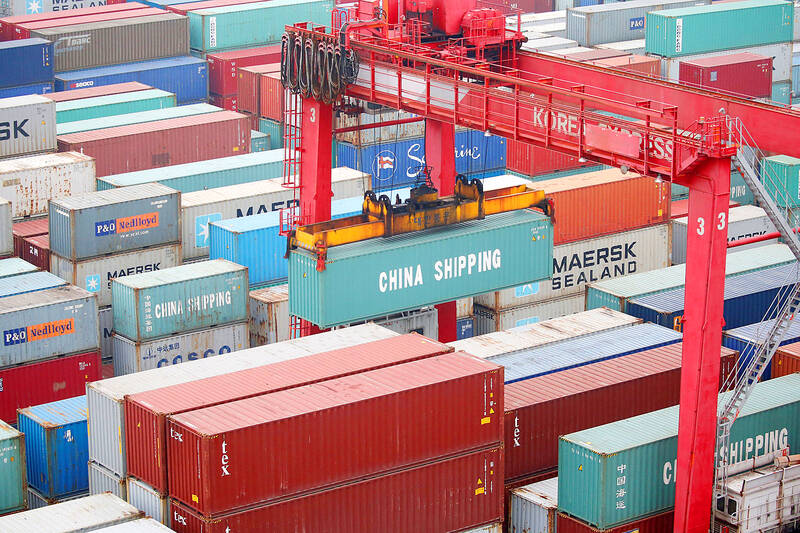South Korea’s exports maintained growth momentum last month as demand from China increased and semiconductor sales stayed resilient.
The value of shipments adjusted for working-day differences increased 4.3 percent from a year earlier last month, according to data released yesterday by the South Korean Ministry of Trade, Industry and Energy. That compared with a 3.7 percent rise initially reported for the full month of November.
Unadjusted exports rose 6.6 percent while overall imports increased by 3.3 percent, resulting in a trade surplus of US$6.5 billion.

Photo: Reuters
The up-tick offers some solace for a nation undergoing its biggest political upheaval in years. South Korean President Yoon Suk-yeol was impeached after shocking the nation by briefly declaring martial law on Dec. 3. South Korean Prime Minister Han Duck-soo was also impeached for refusing to quickly appoint judges to deliberate on Yoon’s impeachment. South Korean Minister of Finance Choi Sang-mok has stepped in as the second acting president.
The turmoil has sent the won to its lowest level since 2009, while South Korea’s stock markets also remain fragile. A Jeju Air plane crash on Sunday that killed all but two of 181 people on board might further dent consumer sentiment.
South Korea, which relies heavily on exports to drive its economic growth, also faces external challenges. US president-elect Donald Trump has promised an array of protectionist policies, including universal tariffs, as he prepares to return to the White House.
Bank of Korea Governor Rhee Chang-yong sees the economy growing this year less than the 1.9 percent forecast previously, and economists increasingly expect the central bank would go ahead with another cut this month as consumer and business confidence slump.
Weaker export momentum poses a threat to the won, and the nation’s semiconductor industry might experience slower demand this year after enjoying a boom from artificial intelligence development.
Chip exports increased 31.5 percent from a year earlier last month while shipments of cars fell 5.3 percent. Sales of wireless communication devices rose 16.1 percent, the trade ministry said.
Exports to China increased 8.6 percent, reversing from a contraction a month earlier, the ministry said. Shipments to the US rose 5.5 percent and exports to the EU advanced 15.1 percent.
For the year as a whole, South Korea’s exports rose 8.2 percent last year from a year earlier, the ministry said, adding that the trade surplus amounted to US$51.8 billion. Semiconductors, the biggest driver of exports, sold 43.9 percent more than in 2023, it said.
The outlook for this year is less bright. Exports are likely to grow 2.2 percent from a year earlier, while the trade surplus is set to reduce to US$48.7 billion, the Korea Development Institute said in a November forecast.

Taiwan Semiconductor Manufacturing Co (TSMC, 台積電) last week recorded an increase in the number of shareholders to the highest in almost eight months, despite its share price falling 3.38 percent from the previous week, Taiwan Stock Exchange data released on Saturday showed. As of Friday, TSMC had 1.88 million shareholders, the most since the week of April 25 and an increase of 31,870 from the previous week, the data showed. The number of shareholders jumped despite a drop of NT$50 (US$1.59), or 3.38 percent, in TSMC’s share price from a week earlier to NT$1,430, as investors took profits from their earlier gains

In a high-security Shenzhen laboratory, Chinese scientists have built what Washington has spent years trying to prevent: a prototype of a machine capable of producing the cutting-edge semiconductor chips that power artificial intelligence (AI), smartphones and weapons central to Western military dominance, Reuters has learned. Completed early this year and undergoing testing, the prototype fills nearly an entire factory floor. It was built by a team of former engineers from Dutch semiconductor giant ASML who reverse-engineered the company’s extreme ultraviolet lithography (EUV) machines, according to two people with knowledge of the project. EUV machines sit at the heart of a technological Cold

TAIWAN VALUE CHAIN: Foxtron is to fully own Luxgen following the transaction and it plans to launch a new electric model, the Foxtron Bria, in Taiwan next year Yulon Motor Co (裕隆汽車) yesterday said that its board of directors approved the disposal of its electric vehicle (EV) unit, Luxgen Motor Co (納智捷汽車), to Foxtron Vehicle Technologies Co (鴻華先進) for NT$787.6 million (US$24.98 million). Foxtron, a half-half joint venture between Yulon affiliate Hua-Chuang Automobile Information Technical Center Co (華創車電) and Hon Hai Precision Industry Co (鴻海精密), expects to wrap up the deal in the first quarter of next year. Foxtron would fully own Luxgen following the transaction, including five car distributing companies, outlets and all employees. The deal is subject to the approval of the Fair Trade Commission, Foxtron said. “Foxtron will be

INFLATION CONSIDERATION: The BOJ governor said that it would ‘keep making appropriate decisions’ and would adjust depending on the economy and prices The Bank of Japan (BOJ) yesterday raised its benchmark interest rate to the highest in 30 years and said more increases are in the pipeline if conditions allow, in a sign of growing conviction that it can attain the stable inflation target it has pursued for more than a decade. Bank of Japan Governor Kazuo Ueda’s policy board increased the rate by 0.2 percentage points to 0.75 percent, in a unanimous decision, the bank said in a statement. The central bank cited the rising likelihood of its economic outlook being realized. The rate change was expected by all 50 economists surveyed by Bloomberg. The